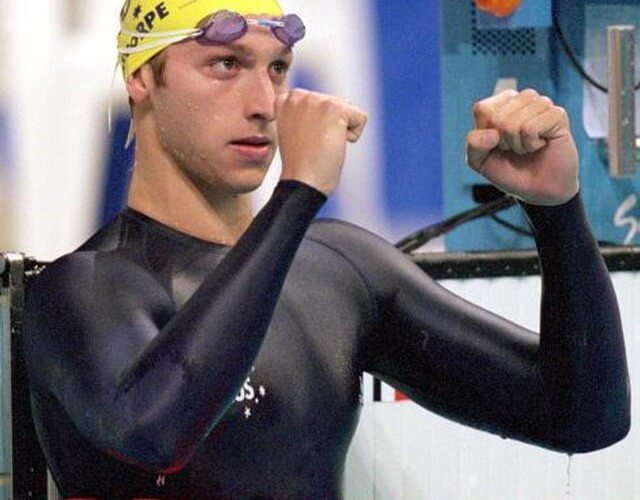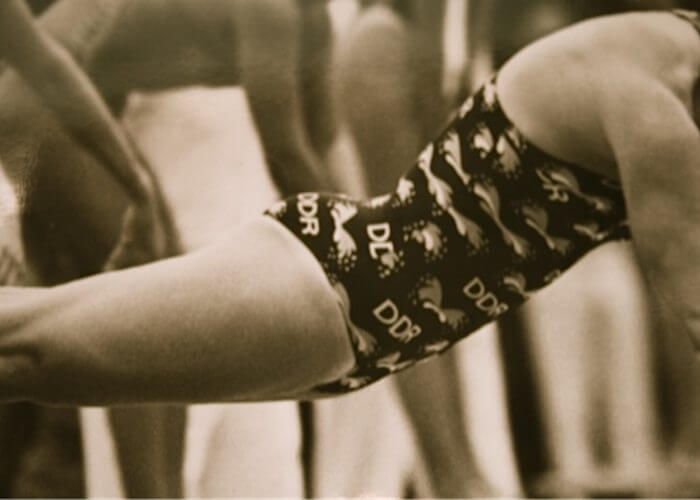How Adam Peaty Ends The Decade As The First Swimmer To Exceed GDR’s “Human Limit”

Will the swim pace of 2020 match the speed of the sport predicted for the year 2000 by East Germany back in 1981? At a glance, not a chance… but then, there’s Adam Peaty.
The British breaststroke ace has not only exceeded the 59.3 – along with others that the generation led by Roman Sludnov almost got to after the Russian had led the way below the minute – predicted in 1981 as “the pace of 2000”: he’s cracked the 57.3 the masterminds at the helm of State (doping) Plan 14:25 believed would be the human limit of possibility for man over 100m breaststroke.
No other swimmer has matched the GDR’s “Dreamworld limit” prediction of hitting the human buffer.
Peaty, on 56.88 as he nailed “Project 56” to the mast with a sledgehammer at World Championships back in July in Gwangju, Korea, has lived up to the Phelpsian mantra that projected Michael of that name to becoming the most decorated Olympian of all-time and the biggest achiever in Olympic sport of the 21st Century as the second decade comes to a close: “No Limits”.
In 1981, eight years before the Berlin Wall would fall, sports scientists, coaches and Stasi operatives gathered around a table and tried to calculate where world records could reasonably be expected to get to by the year 2000 and at what level humans would reach their swim-speed limit.
A chart was compiled, one that might even have been used to control the amount of progress necessary in the pool to stay a stroke ahead in the Cold War in the pool.
That chart was published in a GDR magazine, a large volume of which forms part of the Craig Lord archive of interesting things.
The GDR masterminds were trying to work out what might be achieved on the basis of extrapolating progress achieved from 1972-1980/1 and it ran under the headline:
Dreamworld or Real Possibility?
Many will thank heavens that the Berlin Wall did indeed fall. For the purposes of this exercise let’s start with some predictions for the Wundermädchen, followed by a glance at the men:
The first time in each column was the prevailing world record; the second column the speed expected by 2000 and the third column the ultimate speed past which they did not see humans managing to get.
Women:
- 100m free: 54.79 (WR in 1981); 51.1 (2000); 49.0 (limit)
- 400m free: 4:06.28; 3:49.6; 3:40.3
- 100m breast: 1:10.11; 1:05.4; 1:02.7
- 100m ‘fly: 59.26; 55.2; 53.0
- 200m back: 2:11.77; 2:02.8; 1:57.9
- 400m medley: 4:36.29; 4:17.6; 4:07.1
The women’s limit times are standard among men in most events, beyond all but the space of Thorpey in textile over 400m free and beyond the scope of the best four men ever in textile over 400IM. Lethal Leisel Jones made the 2000 time over 100m breaststroke six years later than the GDR had expected to see a 1:05 low over 100m breaststroke.
Sarah Sjostrom and Regan Smith have edged towards the 2000 predictions in their events in the latter part of the decade about to close, while Katie Ledecky and Katinka Hosszu would have had their work cut out had the GDR been able to produce athletes capable of the times above.
What on earth would the men be expected to get down to? Well, two ‘human limits’ are now within reach (100 ‘fly and 200 free) and one has been exceeded: the 56.88 of Adam Peaty (19 years after it was supposed to have happened, of course) is beyond GDR ‘human limit’:

Michael Phelps – Photo Courtesy: Paul Younan
Men:
- 100m free: 49.44; 46.6; 45.1
- 200m free: 1:46.16; 1:42.9; 1:39.5
- 400m free: 3:50.49; 3:37.3; 3:30.1
- 100 breast: 1:02.86; 59.3; 57.3
- 100 ‘fly: 54.15; 51.1; 49.4
- 100m back: 55.49; 52.3; 50.6
- 200m IM: 2:03.24; 1:56.3; 1:52.4
- 400m IM: 4:20.05; 4:05.2; 3:57.1
Note the difference in women and men in terms of what truly has been achievable and achieved in the intervening years.

Ian Thorpe – Photo Courtesy: Adidas
The 2000 prediction left the likes of Ian Thorpe and Michael Phelps looking ahead of their time (in the GDR mind), Roman Sludnov’s historic dip below the minute looked impressive, as did Ian Crocker‘s 100 ‘fly and Ryan Lochte‘s 200IM.
As you might expect, given the building block of the predictions [oral turinabol and that sort of thing], the women don’t get quite so close. Lethal Leisel Jones managed it, six years late through the GDR’s crystal ball.
Given the longevity of GDR women’s performances in terms of maintaining a place in the all-time top 50 best ever long after the fall of the Berlin Wall, it seemed possible that there may be some correlation between their very slow slide out of currency and the advent of buoyancy and related advantages in what was allowed to happen with suits in 2008. The comparative dramatic drop out of the ranks in the past year is undeniable.

What suited the GDR – Photo Courtesy: NT Archive/Craig Lord
Here are the numbers on GDR women left in the all-time top 50 across all Olympic solo events in Olympic years 1992 to 2008, including one solitary year, that of 2007, as a marker of where we’d got to before fast-forward year dawned in the pool as the shiny suits kicked in:
- 1992: 125
- 1996: 117
- 2000: 88
- 2004: 61
- 2007: 40
- 2008: 21
By the close of 2009, it was single digits in the top 50.
A trawl of the all-time top 100 lists at the end of the first 20 years of the century reveals 37 remaining GDR performances among the remaining women whose times from the 1980s survived yet another decade at that lofty level. The next decade will surely see them confined to a history beyond the best 100 swims ever across all Olympic events.



